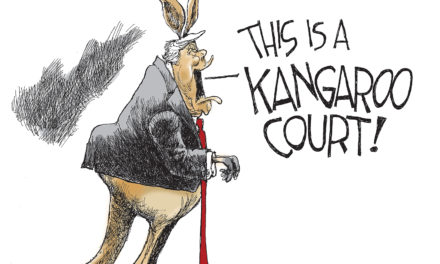In the not-too-distant future, government in Memphis and Shelby County will look nothing like it does today.
And it will happen with or without consolidation.
Voters outside Memphis who reflexively oppose the merger of Memphis and Shelby County governments haven’t grasped the realities of this brave new world. If they had, they might decide they prefer consolidation to the government behemoth that Memphis will become when it’s fully annexed out.
We hear rumblings from Memphis City Council that there is likely to be a renewed push to annex area to the east and southeast as a way to address the city’s problematic budgets. Meanwhile, town mayors like Germantown’s Sharon Goldsworthy rattle the saber over consolidation for their political benefits in light of the seminal fact that the Charter Commission seems to have responded to many of her concerns. It often just appears that people get fixed in their positions and just quit listening, because the facts might suggest that their positions are self-defeating.
Big Shelby Becomes Big Memphis
For example, when Memphis completes the annexation agreements reached in the wake of the “tiny town” controversy of the late 1990s, 65 percent of Shelby County will be inside Memphis. That’s almost 50 percent larger than today and about the same land area as the city of Los Angeles.
The fixed order will be transformed, and smaller cities will find that their future is no longer defined by their relationship with Shelby County, but with Memphis. It will overshadow and drive the futures of all the other cities in Shelby County even more directly than now. Meanwhile, Shelby County government will morph from a major force in our community to a government more like rural counties that deliver little more than schools, jails and justice, and public health.
Outside Memphis, only annexation provokes more enmity than consolidation. It was a similar anti-annexation attitude that led to Nashville’s successful consolidation 46 years ago. Faced with the choice of consolidating governments or being annexed by Nashville, voters in Davidson County opted for the merger.
Lessons from the East
But there was something else. The consolidation vote in Nashville became a referendum on who voters had the most confidence in — the county executive or the city mayor. In the end, it was Davidson County Judge Beverly Briley, a staunch consolidation advocate, who won the vote of confidence and became the first mayor of the new consolidated government.
That too offers a useful lesson for consolidation proponents here.
Getting behind the merger of Memphis and Shelby County governments runs counter to everything the mayors of the municipalities now believe, but at a time not too far in the future they may look back and realize that they missed their best chance to negotiate what they want most in return for supporting consolidation — frozen school boundaries, special school districts, and freedom to control development in their annexation areas.
By then, they will have watched as Memphis ballooned and Shelby County government dwindle away.
Downsizing County Government
As Memphis expands, the grand experiment that began 32 years ago to reinvent Shelby County Government as an urban government comes to a close.
It began with such promise on a clear, unseasonably warm New Year’s Day in 1976 when Shelby County’s first mayor, Roy Nixon, took office and sent the clear message that he was intent on creating a “strong mayor” form of government that would demand equal footing with the mayor of Memphis.
In the two decades that followed, county government achieved Nixon’s founding vision and more, taking on such a strong Memphis focus that it prompted a rivalry between Memphis and Shelby County Governments and the men who were elected to their highest offices. The uncomfortable alliance was often punctuated with dueling press releases and with one mayor elbowing the other out of the way at groundbreakings and major announcements.
Double Trouble
Joint projects became the norm — even though it meant that Memphians were being taxed twice for many of the same services — and Shelby County Government set up new programs for senior citizens, urban neighborhoods, downtown redevelopment, and economic development that were aimed at convincing Memphians that county government mattered to them.
It was light years from the county government that was so rurally dominated that it was ground zero for the landmark U.S. Supreme Court’s “one man one vote” ruling in Baker vs. Carr that changed reapportionment not only for Shelby County, but for every legislative body in the entire country. Until then, although the majority of Shelby County’s population had always lived inside Memphis, the majority of the county’s legislative body members was from outside Memphis.
This new urban majority and focus provoked new momentum to adopt a modernized structure for county govern- ment. When Nixon took the oath of office in 1976, he headed up a new government that mirrored the structure of Memphis city government. There was the hope that the similarity would be so obvious that voters would see the overwhelming logic of consolidation.
Heavy Lifting
It was not to be. Not only was there not a vote on consolidation, but in the end, instead of having just one massive urban government, taxpayers had two that they could not afford — each today with more than 6,000 employees and tax rates of $3 and $4 per $100 of assessed value. The burden was especially heavy for Memphians who paid 100 percent of the city property taxes and about 70 percent of the county’s, prompting a historic hollowing out of the city’s middle class.
In time, something had to give, and there were two options.
One was for Memphis to whittle back its services to mimic other cities — mainly police, fire, and sanitation — while Shelby County took responsibility for museums, libraries, parks, and schools, moving their budgets to its broader base of taxpayers and cutting the Memphis tax rate to a level comparable to Germantown and Collierville.
The other option was for Shelby County to yield the field to Memphis and scale back to the traditional services provided by most counties in Tennessee — jails, elections, schools, and public health.
Blurred Vision
A newspaper headline from a few months ago seemed innocuous, but in truth said volumes about which option was chosen. It said that Shelby County intended to sell its only golf course. The subtext was that county government was ridding itself of services considered to be typically urban. It had already eliminated funding for libraries.
These changes reversed a trend that began in the earliest days of the new restructured county government. From the beginning, it blurred the lines between urban and rural services. The philosophy until that time was that if people outside Memphis wanted higher quality law enforcement and fire protection, they would get it through annexation. But with county government providing urban level services, resistance to annexation by Memphis deepened.
Then, to compound that mistake, county officials threw good money after bad by fueling unbridled sprawl and by never meeting a developer’s project that they didn’t like. With much of their political base lying outside Memphis, this special attention made political sense for the mayor and a majority of the board of commissioners, who thought it was the only way to keep white voters inside Shelby County.
Back to Future
Thirty-two years and $1.6 billion in debt later, Shelby County government is down-shifting and the structure once hailed as a “twenty-first-century county government” is destined to atrophy.
Ironically, the lasting impact of this experiment may be the one most subjected to ridicule over the years — the office of the county mayor. Other county executives were so impressed by the higher profile that resulted from being called “mayor” that a state law was passed. Now every Tennessee county has a mayor.





Tom, you know where a lot of the bodies are buried. I go back a ways myself, and even further through my dad and his friends (Roy, Bill, etc.); but I get the feeling you are trying to drum up interest in a struggle over deck chairs on the Titanic.
This has always been a shipping town, and shipping towns need roustabouts. Roustabouts don’t need much brains; and roustabouts we got. But air is increasingly important, and airports can sprout up fairly quickly. Fred Smith could tell this whole city to go to Hell and move HIS thing in a couple of years to some horny, grateful, better, less crime-, welfare-, bastardy-infested and over-taxed location.
We now have what in my eyes is a bunch of non-brilliant nobodies trying to write a county constitution that seems chartered to gut the sheriff but to leave the county proletariat’s baby-sitting socialist public school service unmerged with the thug-infested city proletariat’s baby-sitting socialist public school service.
Does Wintermute ever like anything or say anything good or constructive – just negativity in all of his comments. Get a life – if you are not part of the solution, you are part of the problem
Wintermute,
Thanks for the confidence.
“….to compound that mistake, county officials threw good money after bad by fueling unbridled sprawl and by never meeting a developer’s project that they didn’t like.”
Unfortunately, they are trying to bring this back in 2010 by electing Joe Ford, one of the sprawl meisters’ chief lapdogs, who not only always liked all developers’ projects but especially likes the green they throw to their friends.
Wintermute:
Moving the deck chairs on the Titanic is what we’ve been doing the past 4 decades, since we crashed into the “no consolidation” iceberg. The governments of Memphis and Shelby have dueled themselves to the point of paying a ton of money for efficiency studies when the best efficiency would be to merge the two governments.